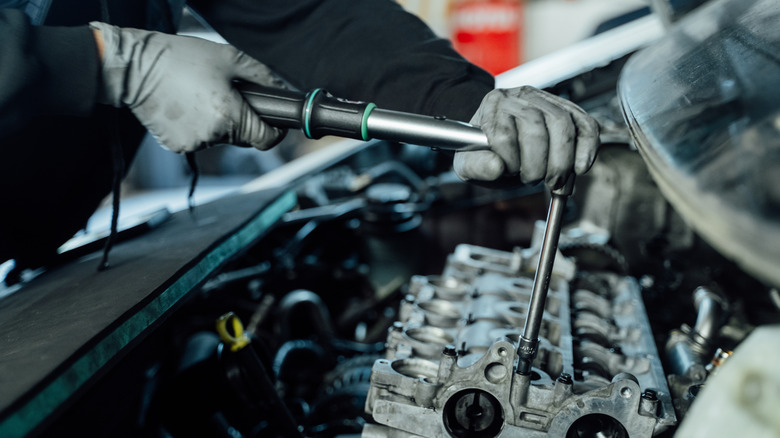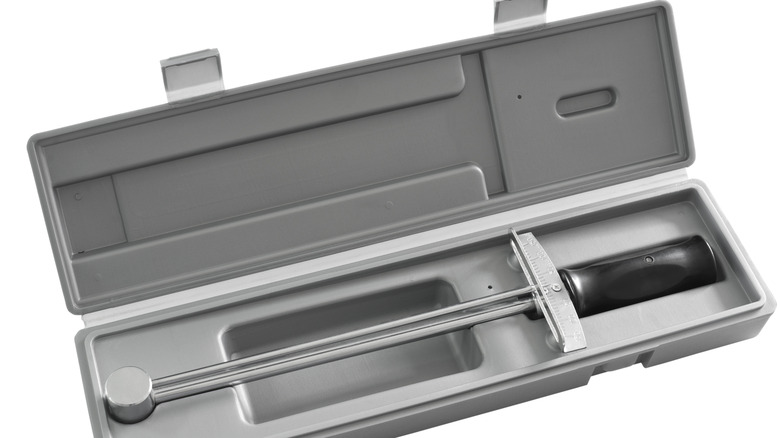Understanding Your Torque Wrench: How Does It Work And How Do You Use The Tool?
A torque wrench (pronounced "tork") is one of the essential tools you need before starting an engine rebuild, and helps determine when the appropriate amount of force has been applied to a fastener like a bolt or nut. Measured in foot-pounds (ft-lbs) or Newton-meters (Nm), torque is defined as the rotational force acting on an object. Torque and horsepower are different ways to quantify the output of engines, but the torque applied to fasteners is far weaker than what is measured at an engine's output shaft or the wheels of a car.
To visualize torque measurements, imagine you have a socket attached to a foot-long breaker bar or ratchet handle and it's securely on a lug nut with the bar extending parallel to the ground. Hang a one-pound weight off the very end, and you have one foot-pound of torque on the lug. Manufacturers supply correct torque specifications in owner and service manuals for all the important fasteners on your vehicle, detailing the proper force to be used when tensioning each one. Note that torque and tension are not the same thing: torque is the rotational force applied to the bolt head or nut, while tension is the resulting force on the fastener that keeps it in place.
Using a torque wrench can be simple, but as with most tools, it helps to understand how the tool works and why it's necessary to the task. In construction and automotive work, proper torque is particularly important. Tightened too much, a bolt can strip a thread or crack a casting. Too loose, and fasteners will work themselves free with vibration. Most dangerously, fast-moving components can disengage violently — put more simply, the wheels can fall off.
Different types of torque wrenches
It's very important to set your torque wrench properly, and — like any tool — they are available at different price points and levels of precision. Highly-accurate and costly torque wrenches are best suited to delicate and quality control applications, while lower-cost beam wrenches are cheaper and might deliver less consistent results. Beam wrenches have a long pointer between the drive and handle and use the amount of flex in the handle to indicate the applied torque via a numeric scale. With no audible or tactile feedback provided, beam wrenches rely on a steady hand and close attention from the user.
Top-of-the-line electronic wrenches like Milwaukee Tools' Digital Torque Wrench will beep when the correct torque is reached and show the value on a display. Arguably the best value for the money are simple, inexpensive, and popular click-style torque wrenches.They are set by twisting the indicator handle according to stamped, etched, and/or embossed markings and indicate a fastener is tight enough with an audible click that can usually be felt as well as heard.
Proper calibration is critical to the accuracy of any torque wrench. A well-made torque wrench can lock down hundreds of fasteners without affecting its accuracy, but sticklers or those working on sensitive equipment can have torque wrenches professionally calibrated — many tool repair shops will do this job for a small fee. Some manufacturers even offer free calibration for the lifetime of their tools. If you are renting a torque wrench, you can ask for it to be calibrated before you take it home, but whether buying or renting, make sure to get one with a drive that fits the sockets you intend to use (usually 3/8 or 1/2 of an inch).
How to use a torque wrench
Whether you're replacing a valve cover or torquing the lug nuts on your wheels, the first step is to set the torque wrench according to the specs for that particular fastener. For click-type wrenches, unlock the handle by tuning the knob at its base counterclockwise, then rotate the handle to the correct setting. The numbers and markings on the handle represent the "ones" digit for the torque setting, and most wrenches of this style have the tens digit on the shaft. For example, to set one to 75 lb-ft, turn the handle past 70 on the shaft and line up the 5 on the handle with the vertical line between the 70 and 80 before locking the handle in place.
Fit the correct socket and place it securely over the fastener. With one hand firmly over the pivot point to keep it in place, use the handle to tighten the wrench clockwise with the other. Do this slowly and smoothly, as sudden force can give incorrect readings.You also want to make sure your hands are placed properly and you aren't applying any force to the middle of the torque wrench. Push steadily until the wrench clicks, then stop. If you go too far, loosen the fastener a turn or so and start again.
Tightening subsequent fasteners on the same component can alter the tension on already-torqued nuts and bolts, so be sure to go around and double-check. A good technique is to torque the fasteners down evenly in stages, following a pattern from one bolt to its direct opposite, then moving around so the mating surfaces come together under even tension. In fact, workshop manuals will specify the correct order to follow when tightening cylinder head bolts, and it's common advice to torque lug nuts in a star pattern.


